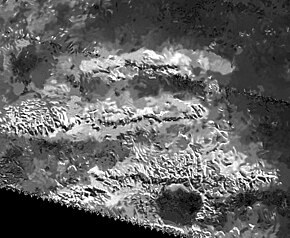Mithrim Montes
 | |
| Feature type | Mountain range |
|---|---|
| Coordinates | 2°S 127°W / 2°S 127°W |
| Diameter | 147 km |
| Eponym | Mithrim Mountains |
The Mithrim Montes /ˈmɪθrɪm ˈmɒntiːz/ are a range of mountains on Titan, the largest moon of the planet Saturn. The range is located near Titan's equator, between 1-3° south and 126-8° west [1] and consists of three parallel ridges that are oriented east-west, spaced about 25 km apart.[2] They are located within the region Xanadu.[3] The highest peak is about 3,337 m (10,948 ft) high and is located on the southernmost of the ridges; it is the highest known peak on Titan.[2]
The Mithrim Montes are named after the Mithrim Mountains, a range in J. R. R. Tolkien's fictional world of Middle-earth.[1] This follows a convention that Titanean mountains are named after mountains in Tolkien's work.[4] The name was formally announced on November 13, 2012.[5]
References
- ^ a b International Astronomical Union. "Mithrim Montes". Gazetteer of Planetary Nomenclature. Accessed Nov 14, 2012.
- ^ a b "PIA20023: Radar View of Titan's Tallest Mountains". photojournal.jpl.nasa.gov. Jet Propulsion Laboratory. 2016-03-24. Retrieved 2016-03-25.
- ^ United States Geological Survey. "Titan with VIMS background and RADAR strips". Accessed 14 Nov, 2012.
- ^ International Astronomical Union. "Categories for Naming Features on Planets and Satellites". Gazetteer of Planetary Nomenclature. Accessed Nov 14, 2012.
- ^ Jennifer Blue, "Eight New Names for Titan Surface Features" Archived 2014-02-22 at the Wayback Machine. USGS Astrologeology Science Center. Nov 13, 2012.
See also

